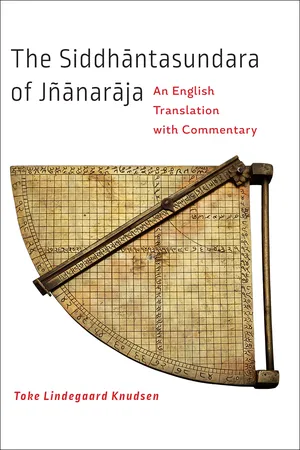
The Siddhāntasundara of Jñānarāja
An English Translation with Commentary
- English
- ePUB (mobile friendly)
- Available on iOS & Android
About this book
The first English translation of this major work of classical Indian astronomy and mathematics.
A treasure for anyone interested in early modern India and the history of mathematics, this first English translation of the Siddh?ntasundara reveals the fascinating work of the scholar-astronomer Jñ?nar?ja (circa 1500 C.E.). Toke Lindegaard Knudsen begins with an introduction to the traditions of ancient Hindu astronomy and describes what is known of Jñ?nar?ja's life and family. He translates the Sanskrit verses into English and offers expert commentary on the style and substance of Jñ?nar?ja's treatise.
The Siddh?ntasundara contains a comprehensive exposition of the system of Indian astronomy, including how to compute planetary positions and eclipses. It also explores deep, probing questions about the workings of the universe and sacred Hindu traditions. In a philosophical discussion, the treatise seeks a synthesis between the cosmological model used by the Indian astronomical tradition and the cosmology of a class of texts sacred in Hinduism. In his discourse, which includes a discussion of the direction of down and adhesive antipodeans, Jñ?nar?ja rejects certain principles from the astronomical tradition and reinterprets principles from the sacred texts. He also constructs a complex poem on the seasons, many verses of which have two layers of meaning, one describing a season, the other a god's activities in that season.
The Siddh?ntasundara is the last major treatise of Indian astronomy and cosmology to receive serious scholarly attention, Knudsen's careful effort unveils the 500-year-old Sanskrit verses and shows the clever quirkiness of Jñ?nar?ja's writing style, his keen use of mathematics, and his subtle philosophical arguments.
Frequently asked questions
- Essential is ideal for learners and professionals who enjoy exploring a wide range of subjects. Access the Essential Library with 800,000+ trusted titles and best-sellers across business, personal growth, and the humanities. Includes unlimited reading time and Standard Read Aloud voice.
- Complete: Perfect for advanced learners and researchers needing full, unrestricted access. Unlock 1.4M+ books across hundreds of subjects, including academic and specialized titles. The Complete Plan also includes advanced features like Premium Read Aloud and Research Assistant.
Please note we cannot support devices running on iOS 13 and Android 7 or earlier. Learn more about using the app.
Information
Table of contents
- Cover Page
- Title Page
- Copyright Page
- Dedication
- Contents
- List of Figures
- List of Tables
- Preface
- Introduction
- 1 Chapter on Cosmology Section 1 Lexicon of the Worlds
- 2 Chapter on Cosmology Section 2 Rationale of Planetary Motion
- 3 Chapter on Cosmology Section 3 Method of Projections
- 4 Chapter on Cosmology Section 4 Description of the Great Circles
- 5 Chapter on Cosmology Section 5 Astronomical Instruments
- 6 Chapter on Cosmology Section 6 Description of the Seasons
- 7 Chapter on Mathematical Astronomy Section 1 Mean Motion
- 8 Chapter on Mathematical Astronomy Section 2 True Motion
- 9 Chapter on Mathematical Astronomy Section 3 Three Questions (on Diurnal Motion)
- 10 Chapter on Mathematical Astronomy Section 4 Occurrence of Eclipses
- 11 Chapter on Mathematical Astronomy Section 5 Lunar Eclipses
- 12 Chapter on Mathematical Astronomy Section 6 Solar Eclipses
- 13 Chapter on Mathematical Astronomy Section 7 Rising and Setting of Planets
- 14 Chapter on Mathematical Astronomy Section 8 Shadows of Stars, Constellations, Polestars, and So On
- 15 Chapter on Mathematical Astronomy Section 9 Elevation of the Moon’s Horns
- 16 Chapter on Mathematical Astronomy Section 10 Conjunctions of Planets
- 17 Chapter on Mathematical Astronomy Section 11 Occurrence of Pātas
- References
- Index
- Footnotes